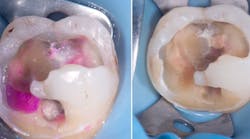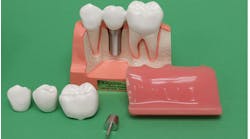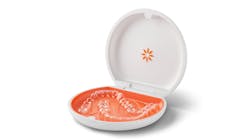One of the primary reasons why additive composite resin material is frequently scrutinized as a replacement material for larger posterior defects revolves around the concept of C-factor.1 Polymerization shrinkage has consistently raised questions about the suitability of resin in everyday dental material selection.2 This inherent property of direct composite restorations has historically favored indirect restorations as the gold standard for addressing substantial posterior defects. However, this paradigm has evolved over time with significant improvements in materials. In this brief case study, we will examine a specific clinical case that serves as an illustrative example of how today’s materials have transformed our perspective on direct composite materials in routine dentistry.3
Case study
When assessing posterior dentition featuring sizable existing amalgam restorations, often accompanied by cracks and potential leakage, the pivotal decision point emerges when choosing between indirect and direct restorations. As dentists, we yearn for the ability to make this choice seamlessly after removing the existing restorations and evaluating the volume that requires replacement. While both options may be viable for presentation to our patients, the current properties of direct composite materials have revolutionized our confidence in their functionality and the ultimate esthetic results.
You may also be interested in ... 10 years of clinical success with composite resin technology: Case studies
In this specific clinical case, it is evident that the consideration of pursuing indirect restorations arises from the outset. With existing amalgam restorations, coupled with cracks and caries (figure 1), this molar necessitates optimal fatigue resistance, particularly as the adjacent molar is absent. Our primary objective, irrespective of the materials under consideration, is to preserve the greatest amount of healthy tooth structure during the procedure to ensure longevity. Additionally, this molar may serve as a potential anchor for orthodontic uprighting, should the patient opt for implant placement adjacent to the tooth.
The incorporation of caries-indicating dye proves highly beneficial in clinical scenarios such as this one.4 As mentioned earlier, the primary consideration in selecting a replacement material is the comprehensive removal of all elements requiring extraction, including existing restorations, caries, and decalcification. Once this removal process is completed, and we are left with a foundation of healthy and restorable tooth structure, it becomes apparent that the number and depth of the remaining walls can give rise to concerns about shrinkage and the C-factor (figure 2). Additionally, if we opt for indirect restorations, it is essential to continue the preparation with an awareness of factors such as material thickness, undercuts, and the path of insertion.5
The extensive quest for solutions to postpolymerization shrinkage, C-factor, or what is often referred to as V-factor (volume factor), leads to groundbreaking findings when exploring fiber-reinforced composites as a substitute for bulk dentin.3 This material stands out as the sole option that enables us to achieve fatigue resistance comparable to that of indirect restorations. Fiber-reinforced composites are currently available in two forms: packable composites with longer fibers and injectable/flowable forms with shorter fibers but a higher number of them (EverX Posterior and EverX Flow, GC America). The use of this material not only promises a favorable outcome but also makes the choice of the direct approach more reassuring. Opting for the direct route allows us to bypass further tooth preparation at this point. It’s crucial to note that fiber-reinforced composites aren’t designed for exposure to the oral environment. Therefore, in such cases, we initiate the process by constructing proximal/circumferential walls before applying the fiber-reinforced material as a replacement for bulk dentin (figure 3). EverX Flow makes application and adaptation of this fiber bulk extremely easy and efficient.6
Selection of a direct composite material to finalize the proximal/occlusal aspects of the restoration is just as crucial as the bulk material. In a sense, considering all the effort and steps invested in achieving the performance level of an indirect restoration, it is imperative to ensure a matching level of esthetics. To achieve this, we need materials with compositions that exhibit the following characteristics: wear and stain resistance, optimal handleability, ideal polishability, and natural color properties.
You may also be interested in ... Reducing composite resin failures
For this case, the preferred material choice with these characteristics is the G-ænial A’CHORD system (GC America).7,8 The simplified shade options, coupled with exceptional performance of the composite, make it an excellent choice for such restorations. In this instance, we used dentin layers A3 and A2 to build the facial wall, completing the occlusal aspect of the restoration with the A2 dentin shade exclusively. A composite brush is used to adapt the material to the existing cusps and walls. Once the final shape is achieved, the application of stains helps to create a more natural-looking restoration (figure 4).
Conclusion
Today, advancements in the realm of direct composite restorations have completely revolutionized their integration into everyday dentistry (figure 5). Direct composite restorations currently stand out as the most additive tooth replacement approach, prompting continuous efforts from dental researchers to assess and enhance their performance.
Through the strategic combination of appropriate materials, this case showcases an outcome demonstrating esthetic excellence along with functional properties. It is crucial to emphasize that caries removal and bonding protocols play pivotal roles in creating a durable and lasting result. Proper isolation, use of caries-indicating dye, implementation of an air-abrasion system, and meticulous bonding are all essential in achieving an ideal final product.
Discussion
The primary focus in this specific case study was to demonstrate how advancements in today’s composite materials have brought us closer to achieving outcomes comparable to indirect restorations. It is worth noting that the bonding protocol plays a crucial role in this endeavor. Achieving an ideal bond to dentin and enamel is a complex topic extensively covered in numerous scientific articles highlighting ongoing challenges. It is essential to recognize that various factors in similar clinical cases may favor indirect restorations as the superior choice. Factors such as occlusion, parafunctional habits, and the condition of the opposing dentition should always be carefully considered when making decisions about materials.
Acknowledgments: My hard-working dental assistants and all staff at Mehrdad Razaghy, DDS. Sam Alawie, MDT, and his team at Beverly Hills Dental Laboratory. My incredible mentor, Dr. Pascal Magne. Two individuals who inspire me on a daily basis: Michel Magen, MDT, and Abdi Sameni, DDS. My loving wife, Sara Mokhtari.
Editor's note: This article appeared in the February 2024 print edition of Dental Economics magazine. Dentists in North America are eligible for a complimentary print subscription. Sign up here.
References
- van Dijken JWV. Durability of resin composite restorations in high C-factor cavities: a 12-year follow-up. J Dent. 2010;38(6):469-474. doi:10.1016/j.jdent.2010.02.007
- Zhang N, Xie C. Polymerization shrinkage, shrinkage stress, and mechanical evaluation of novel prototype dental composite resin. Dent Mater J. 2020;39(6):1064-1071. doi:10.4012/dmj.2019-286
- Soares LM, Razaghy M, Magne P. Optimization of large MOD restorations: composite resin inlays vs. short fiber-reinforced direct restorations. Dent Mater. 2018;34(4):587-597. doi:10.1016/j.dental.2018.01.004
- Kidd EA, Joyston-Bechal S, Smith MM, Allan R, Howe L, Smith SR. The use of a caries detector dye in cavity preparation. Br Dent J. 1989;167(4):132-134. doi:10.1038/sj.bdj.4806939. PMID: 2789871
- Veneziani M. Posterior indirect adhesive restorations: updated indications and the Morphology Driven Preparation Technique. Int J Esthet Dent. 2017;12(2):204-230
- Kapoor N, Bahuguna N, Anand S. Influence of composite insertion technique on gap formation. J Conserv Dent. 2016;19(1):77-81. doi:10.4103/0972-0707.173205
- Molina GF, Cabral RJ, Mazzola I, Burrow M. Surface gloss, gloss retention, and color stability of 2 nano-filled universal resin composites. Restor Dent Endod. 2022;47(4):e43. doi:10.5395/rde.2022.47.e43
- Satoshi J, Machida D, Fusejima F. Esthetic and mechanical durability of direct-filling resin composite. IADR Abstract Archives. 51st Annual Meeting & Exhibition of the AADOCR. 46th Annual Meeting of the CADR. J Dent Res. 2022;101(Spec Iss A):Final Presentation ID 0367. https://iadr.abstractarchives.com/abstract/51am-3664407/esthetic-and-mechanical-durability-of-direct-filling-resin-composite
With an extensive medical and dental research background, Mehrdad Razaghy, DDS, is an active international lecturer and currently teaches multiple continuing education modules in the fields of dental photography, additive dentistry, resin bonding, digital smile design, rubber dam isolation, and bonded porcelain ceramic restorations. He is a member of a prestigious national group of dentists called the Bio-Emulation and continues to contribute to dental education alongside his mentor, Dr. Pascal Magne.











